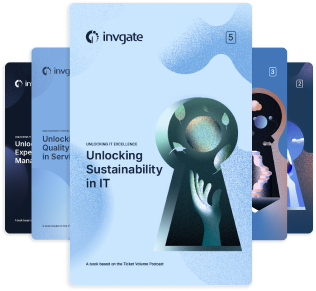Implementing sustainable IT practices is more crucial than ever. With growing environmental concerns, the need to adopt green IT initiatives has become a priority for many organizations. As we witness the rapid advancement of technology, it’s clear that we must also focus on minimizing its environmental footprint.
This isn't just about being eco-friendly; it’s about ensuring the longevity and efficiency of our IT operations while contributing positively to the planet.
Drawing from expert discussions featured in our latest Ticket Volume eBook, “Unlocking Sustainability in IT: Keys to a Future-Ready IT Practice,” we aim to inspire and guide you on this journey. Whether you’re an IT manager looking to overhaul your department’s practices or an IT professional seeking to implement greener solutions in your daily tasks, there’s something here for everyone.
Don’t forget to download the eBook for more in-depth insights! And you can check out the entire ”Unlocking IT” eBook series here. Let’s embark on this journey towards a greener, more sustainable IT future together.
Download Unlocking Sustainability in IT: Keys to a Future-Ready IT Practice
Unlocking Sustainability in IT
Discover the importance of embracing sustainability in IT.
Download for free
What is Green IT?
Green IT, also known as green computing, is all about being mindful of our environmental impact when it comes to technology. Picture this: every time you boot up your computer, send an email, or stream a video, there’s a hidden environmental cost.
Green IT aims to minimize that cost by making the entire lifecycle of technology—from design and manufacturing to usage and disposal—as eco-friendly as possible.
So, what does this look like in practice? Let’s start with the basics. When designing and manufacturing computers, servers, and other IT equipment, green IT encourages the use of energy-efficient materials and processes. This might mean using components that require less power, opting for renewable energy sources in manufacturing plants, or even designing products that are easier to recycle at the end of their life.
Green IT also focuses on how we use our technology. This includes everything from optimizing software to run more efficiently, thereby using less power, to implementing smarter data center management practices. For example, a well-managed data center might use virtualization to reduce the number of physical servers needed, cutting down on both energy consumption and heat production, which in turn reduces cooling requirements.
The goal of green IT is to shrink the carbon footprint of our tech activities. This means being conscientious about the energy we use, the waste we produce, and the materials we consume. By adopting sustainable practices, IT departments not only contribute to a healthier planet but also often find that they can save money and increase efficiency in the long run.

What are the primary goals of green IT?
The primary goals of green IT include:
- Reducing energy consumption: Implementing energy-efficient technologies and practices to minimize the power usage of IT systems.
- Minimizing e-waste: Ensuring proper disposal and recycling of obsolete hardware to prevent environmental contamination.
- Promoting sustainable practices: Encouraging the adoption of practices that reduce the environmental impact of IT operations.
- Enhancing economic sustainability: Reducing operational costs through efficient use of resources and sustainable procurement policies.
Why should IT departments care about IT sustainability?
As the backbone of modern business operations, IT departments play a crucial role in shaping how organizations impact the environment. Understanding and embracing IT sustainability can lead to numerous benefits that extend beyond just environmental considerations. Here’s why IT departments should prioritize sustainability:
- Environmental impact: The IT industry significantly contributes to global carbon emissions. Data centers alone account for about 1% of the world’s electricity consumption. With the increasing reliance on digital services, this percentage is only expected to rise. By adopting sustainable practices, IT departments can help reduce the industry's overall environmental footprint and contribute to global efforts to combat climate change.
- Regulatory pressures: Governments worldwide are enacting regulations to reduce environmental impact, compelling IT departments to adopt sustainable practices. These regulations and compliance standards are becoming more stringent, and non-compliance can lead to hefty fines and legal challenges. Staying ahead of these regulations not only ensures compliance but also positions the organization as a leader in sustainability.
- Cost savings: Energy-efficient technologies and practices can lead to substantial cost savings in the long run. By reducing energy consumption and optimizing resource use, IT departments can significantly cut operational costs and improve their IT budgeting efforts. This includes lower energy bills, reduced cooling costs, and less frequent hardware replacements.
- Corporate responsibility: In the eyes of the public and stakeholders, companies are increasingly expected to demonstrate their commitment to sustainability. This commitment can enhance a company’s reputation and attract environmentally conscious customers and investors. IT departments, by leading sustainability initiatives, can play a key role in building a company’s green credentials and fostering trust and loyalty among its stakeholders.
Benefits and challenges of IT sustainability
Embarking on the path to IT sustainability comes with a mix of compelling benefits and notable challenges. Understanding both sides can help IT departments navigate this journey more effectively and make informed decisions.
Here’s a closer look at the advantages and hurdles associated with sustainable IT practices:
Benefits
Cost reduction
One of the most immediate benefits of adopting energy-efficient technologies and practices is the reduction in operational costs. Lower energy consumption translates to reduced electricity bills, and more efficient use of hardware means less frequent replacements and maintenance. Over time, these savings can be substantial, making the initial investments in sustainability well worth it.
Compliance
Adhering to environmental regulations helps prevent legal issues and fines. As governments worldwide impose stricter regulations to curb environmental impact, compliance becomes not just a legal obligation but a strategic advantage. Staying ahead of regulatory compliance can also position an organization as a proactive leader in sustainability.
Enhanced reputation
Demonstrating a commitment to sustainability can significantly improve a company’s corporate image and build customer trust. In today’s market, consumers and investors are increasingly prioritizing environmental responsibility. Companies that lead in sustainable practices often enjoy enhanced brand loyalty and a stronger market presence.
Innovation
Sustainability initiatives can be a catalyst for innovation. The need to reduce environmental impact can drive the development of new technologies and business models. This innovation not only benefits the environment but can also open new business opportunities and competitive advantages. For instance, developing more efficient data management solutions or adopting cutting-edge cooling technologies can set an organization apart.
Challenges
Initial costs
Implementing sustainable technologies and practices often requires significant upfront investment. Whether it’s upgrading to energy-efficient servers or retrofitting data centers with advanced cooling systems, the initial financial outlay can be substantial. However, these costs should be viewed as long-term investments that will pay off over time through reduced operational expenses and enhanced efficiency.
Legacy systems
Many organizations still rely on outdated, energy-intensive systems. Transitioning from these legacy systems to more sustainable alternatives can be complex and costly. It involves not just replacing hardware but also reconfiguring software and processes, which can be disruptive and require careful planning and execution.
Knowledge gaps
A lack of awareness and expertise in sustainable IT practices can hinder implementation. IT professionals need to be educated on the latest sustainable technologies and practices, and this often requires additional employee training programs and resources. Bridging these knowledge gaps is essential for successful sustainability initiatives.
Resistance to change
Organizational inertia and resistance to new practices can pose significant challenges. Employees and management may be accustomed to existing workflows and skeptical of new approaches. Overcoming this resistance requires effective Change Management strategies, clear communication of the benefits, and, often, a cultural shift within the organization.
Expert advice on how to build a sustainable IT department
Encourage personal initiatives
Dr. Tuuli Bell, PhD, emphasizes that sustainability starts with individual actions. Even small initiatives, when combined, can make a significant impact on the environment. She believes that encouraging IT professionals to take personal responsibility in their daily tasks is essential for creating lasting change.
|
|
"Personal initiatives, no matter how small, collectively make a significant impact on our environment." Dr. Tuuli Bell, PhD |
By fostering a culture where every team member feels empowered to make environmentally-conscious decisions—whether it's turning off unused devices or reducing paper consumption – you build a strong foundation for broader sustainability efforts within your IT department.
Foster communication and collaboration
Antonina Douannes, Digital and IT Sustainability Leader and ITIL 4 Lead Editor, stresses the importance of breaking down silos and fostering communication, cooperation, and co-creation across departments.
|
|
"In general, sustainability cannot be achieved in silo, it's all about communication, cooperation, and co-creation. It doesn't matter to which departments we belong, IT plays a huge role, I would say one essential role because that's where a lot of Innovations come from." Antonina Douannes |
Mark Bradley, Senior Product Manager at Flexera, highlights the benefits of virtualization. By consolidating workloads onto fewer servers, organizations can maximize hardware usage, reduce energy consumption, and decrease cooling requirements.
|
|
"Once VMware came in and started allowing us to really take advantage of every inch of capability, we could really start utilizing the servers more efficiently, reducing the number of physical machines required and thereby cutting down on power usage and the associated cooling needs." Mark Bradley |
Leverage cloud computing
Mark Bradley also advocates for cloud computing as a means to enhance sustainability. Cloud providers often use advanced energy-efficient technologies and renewable energy sources, making it a greener option compared to traditional on-premises infrastructure.
|
|
"When you look at an Oracle implementation that was built decades ago and dragged forward and with all kind words, lipstick put on to make it modern, but still have, they need more CPU, more RAM, more disk space, and they're coming bigger and bigger and bigger. Where you, the only way you can run it is in the cloud. How much CPU are you turning and burning? That's the next opportunity. That's our challenge." Mark Bradley |
Cloud computing offers scalable resources on demand, reducing the need for organizations to maintain large, energy-consuming data centers. Cloud providers are increasingly investing in renewable energy and energy-efficient technologies, making cloud computing a sustainable choice for businesses looking to minimize their environmental impact.
Adopt circular thinking in Asset Management
Dr. Bell advocates for a shift away from traditional linear service design and asset management practices, which often involve purchasing new equipment, using it until it breaks, and then replacing it. Instead, she encourages organizations to adopt a more circular approach, where resources are reused, repaired, and maintained for as long as possible.
|
|
"In terms of service design, I think the big shift will be away from linear thinking. And this is a way of thinking that I borrow from circular economy, which is all about reusing." Dr. Tuuli Bell, PhD |
By integrating circular thinking into your IT operations, you can reduce waste, minimize the environmental impact of new purchases, and extend the lifecycle of your assets. This approach not only benefits the planet but also saves your department money by reducing the need for constant hardware replacements.
Adopt a holistic approach to sustainability
Antonina Douannes advises that sustainable IT practices should not just focus on immediate goals but also consider long-term impacts.
|
|
"When we talk about sustainability, we go already on a corporate level and we talk about the business approach that we use to create value for society and other stakeholders, by addressing risks and opportunities in three pillars: economic, environmental, and social." This means integrating sustainability into every aspect of your IT operations, from resource management to social responsibility initiatives, ensuring a balanced approach that benefits both present and future generations." Antonina Douannes |
Engage with the ecosystem
Sustainability isn't a solo endeavor; it's a collective responsibility that requires the active participation of all stakeholders. Antonina Douannes emphasizes the importance of engaging with your ecosystem to ensure your sustainable efforts aren't in vain.
|
|
"We can produce really sustainable products, we can do it in a really sustainable way, but we provide that product for, well let's say, someone who is killing people. Well, are we sustainable in that sense? Well, no. If we provide that for someone who doesn't care about sustainability at all, then all our efforts are actually minimized immediately. Maybe not. Maybe we want to nudge our partners, or we can help them to become more sustainable." Antonina Douannes |
This means encouraging your partners, suppliers, and even customers to adopt sustainable practices. By fostering open communication and collaboration, you can help them see the benefits of sustainability and provide guidance on how they can implement eco-friendly practices. When everyone in the ecosystem is working towards the same goal, the collective impact can be significantly greater. Remember, sustainable progress is more effective when it's a shared journey.
In closing
Building a sustainable IT department is both an environmental imperative and a strategic advantage.
- Foster communication and collaboration: Sustainability requires breaking down silos and fostering cooperation across departments.
- Implement virtualization: Optimize hardware usage and reduce energy consumption by consolidating workloads onto fewer servers.
- Leverage cloud computing: Use advanced, energy-efficient cloud technologies to minimize the need for large, energy-consuming data centers.
- Adopt a holistic approach: Integrate sustainability into every aspect of IT operations, considering economic, environmental, and social impacts.
- Engage with the ecosystem: Encourage partners, suppliers, and customers to adopt sustainable practices, amplifying the collective impact.
By adopting these strategies, IT departments can reduce their environmental footprint while driving innovation and efficiency.















